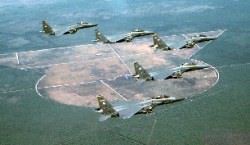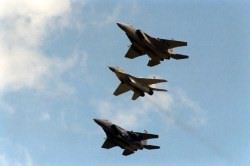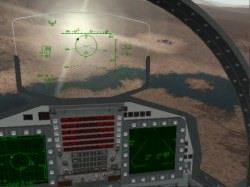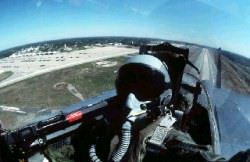| ACM Training: Janes Combat.net by Warren "Big Red" Hudson |
||||
|
Months of preparation, one of those few opportunities, and the judgment of a split second are what makes some pilots an ace, while others think back on what they could have done. Colonel Gregory 'Pappy' Boyington, USMC
Like many of my fellow F-15E sim pilots, I love the challenge of going head-to-head against other "human" sim pilots over the Internet using Jane's Combat.Net. However, I've found that many people come to Combat.Net to fly, but few if any arrive with any idea of what they want to do once they get there and are disappointed at the outcome(s).
This article will attempt to give new sim pilots and some older ones some food for thought on planning for their initial Combat.Net missions. The basis for this article is simple. With some evaluation of your skill level and a little planning: what you want to work on, what scenarios will fit the phase of training you are in, and what options you have.. and a little cooperation from your fellow sim pilots, combat.net can be a rewarding learning environment. The first question you need to ask yourself is, "What do I want to work on?" The skill set that goes into making a fighter pilot or even a sim fighter pilot is varied and the curriculum is long. A person going through fighter-lead-in- training just doesn't arrive at the squadron one-day and hop in the jet the next for a little 4v4 fun. They are trained according to a standard syabullus, which uses a stepping stone approach for advancement. Complete one mission or one block successfully, then you get to advance to the next.
Why then shouldn't sim pilots take the same approach to their training when flying against other sim pilots? You've loaded up F-15E, read the book, seen Combat.Net advertised and you hop on the Internet to the site. Register and there you are. All those callsigns are people just waiting for you to kill! Well- not so fast. They probably have been flying for a while and are just waiting for an easy kill - you!
So let's back up. What do you want to accomplish? First, you probably want to just get into the system and fly to see what it is like, what options are available, how long it takes to sync up, etc. This is called local orientation and it's the first stop fighter pilots make when they start their course work. Normally it's a 2 ship with the trainee as # 2. This can be accomplished on Combat.net as well. Hopefully, you have a friend you know that can meet you there. If not, that's ok too. |
To start, go to Jane's Combat.Net and select casual flight. Why casual? Because it's for beginners and that's you. Log-in and the pilot screen appears. Here you will find the central meeting place for everyone wishing to meet and fight but who want to use less than expert setting. Type in what you like to do in the chat box and enter then click the # 2 position button on one of the 2 person missions. If you have a friend, they can select position # 1. Have the flight lead select fly and off you go. The next screen you see will be the scenario screen. This is where the host selects the parameters of the mission. The host (#1) will select time of day, weather, weapons, regen, and position (so everyone sees where everyone is on the tactical map). Once this is selected, the accept button is clicked and the mission parameters are sent to other players. You can either accept or cancel at his point. Select accept and you will see a map appear with your position # on a colored base. You will also see it in the upper right corner of the screen. Below is a text box. Click it on and you can chat with the other person. To move your position # on the map, just click and drag it to where you wish it positioned (either on the ground at a base or in the air). Call ready (type it in) then select fly. You'll see a loading screen with the version # on it (current version is 1.17) and then you'll appear on the runway or in the air at the position you put your #. If on the runway, hopefully # 1 is lined up in front of you. If not, let him taxi around you and take-off. Run your engine up to full burner (count to 10) and release brakes and you are off. This is called 10 second spacing and is standard for single ship take-off. Airborne - bring your gear and flaps up. Do a systems check as you close on # 1. Cycle through radar modes and lock on to # 1. Test your missiles and tone for sidewinders. Close up and stabilize either right or left of # 1 at 1000' (this will give you some room to maneuver). Each one of the following scenarios would normally count as a syllabus mission in a fighter pilot upgrade program. Except for local orientation, the maneuvering floor is 5,000 feet over the flat area. No maneuvering over the high terrain should take place until later missions. Call Knock-It-Off when one or both reach the floor and set-up again. TRNMSN 1: Go to in-trail about a mile. Let # 1 lead you around the area and look at the sites. Combat.Net area offers a varied play area which is basically an arid land region with vast flats in the south, mountains in the north, east and west, and a large body of water in the north off the coast. There are numerous towns, cities, bridges, towers; etc scattered throughout the area. Many roads run across the area and through the mountains. Airbases are also scattered about. Start at medium altitude and work your way down low. Use the A/G radar to pick out features and then fly over them. You will want to become familiar with these, as they will come in handy in later missions when you drop ordnance on targets. Go to Continued ACM Page 2 of 5
|
|||
|
© 1997 - 2000 COMBATSIM.COM, INC. All Rights Reserved. Last Updated February 22nd, 1999 |
||||




